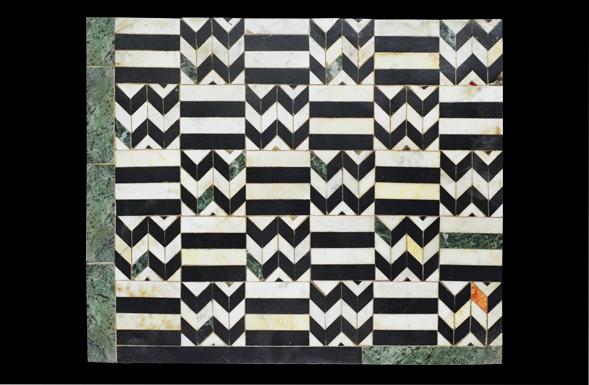

Onde ruvide Cosmati
Beautifully crafted by hand, by artisans who have handed down this craft from father to son
Cosmati pavement (section) consisting of horizontal and zig-zag stripes of Black, White and Green Marbles, hand cut, hand assembled and sensitively aged.
Use as a seamelss pavement, as a repeating tile, as an enlarged version to make a central tableau, change materials and colours, play with different textures... It is all possible at De Ferranti, as we pride ourselves on our ability to be fully customisable.
We are also able to use historic marbles, often extint, if required, as we have sources of old frangments and blocks. These may include Giallo Antico from Numidia, antique green porphyry (serpentine), antique red Egyptian porphyry palombino from Asia Minor, and of course, our vast range of semi-precious stones.
Cosmati work is highly decorative, with inlays of coloured stones, mosaic, glass and gold leaf. A feature of 12th Century Italian architecture, it is named after the Cosma family who were its traditional exponents.
De Ferranti has rediscovered and nurtured this ancient craft and will design, commission and install fabulously detailed Cosmati walls and floors to special order.
Product Specifications:
Bespoke: Yes
Finishes: Antiqued, Custom, Hand Finished, Handcut, Handmade, Honed, Inlaid, Interlocking, Matte, Patinated, Polished, Pre-sealed, Pre-waxed, Seamless
More about Stone & Marble Mosaics:
Very few artistic mediums are as expressive as that depicted by a handmade mosaic
The earliest known examples of mosaics made of different materials were found at a temple building in Mesopotamia, and are dated to the second half of 3rd millennium BC. They consist of pieces of coloured marbles and stones, shells and ivory. However, mosaic patterns were not used until the times of Sassanid Empire and Roman influence. In the 4th BC the colour range was extended by green and red pebbles.
In the ancient world mosaics were basically used for floors and footpaths. Longevity was an important reason for using mosaics. Tesserae made of marble and limestone were particularly suitable for making mosaics especially due to the vast ranges of colours available.
Although the origin of mosaics is accredited to the Greeks, mosaics were also used in Assyria, Egypt, Persia and other ancient civilisations. Roman mosaics enjoyed a good reputation, many designs are still en vogue today. The Romans sophisticated mosaics for the use onto walls and floors in halls, villas and public houses. After the roman era mosaics were integrated in Christian, Byzantine, Persian and Indian architecture.
De Ferranti has its own mosaic workshop near Venice and is proud to be continually breathing life into what could be soon a lost art.
People who viewed this product also looked at:

Scaglie - Polychrome Fish Scale Mosaic
A faithful copy of a mosaic found at the Domvs Romana, Malta more..

Axe Head Border in Black and Burnt Red Stone
Let the colours of Pompei coupled with black limestone enhance your interior setting and mood more..

Hammered Brass Briquettes - Texture I
Looking like part of an ancient temple, these astonishing Brass Briquettes are from De Ferranti’s 'Alchemy' Collection. more..

Scaglie Lunghe - Polychrome Fish Scale Mosaic
A faithful copy of a mosaic from the Baths of Caracalla, Rome more..
By Appointment
DE FERRANTI
South Park Studios - Suite 10
88 Peterborough Road, London SW6 3HH
United Kingdom













